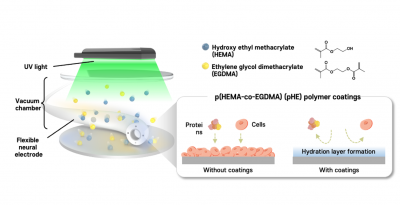Science
Breakthrough Coating Technology Triples Lifespan of Brain Electrodes

A research team led by Dr. Hyejeong Seong at the Korea Institute of Science and Technology (KIST) has developed an innovative coating technology that significantly enhances the longevity of implanted brain electrodes. This advancement increases the lifespan of these crucial devices from approximately one month to over three months, providing a major breakthrough in brain signal recording capabilities.
The collaborative effort involves Prof. Seongjun Park from Seoul National University, underscoring the partnership between two leading research institutions in South Korea. This new technology is expected to have substantial implications for both clinical applications and neuroscience research, enabling longer monitoring of brain activity without requiring the frequent replacement of electrodes.
Enhancing Brain Signal Recording
The primary goal of this research is to improve the effectiveness of brain-computer interfaces, which rely heavily on the reliability of implanted electrodes. Current limitations have hindered their performance, as traditional electrodes often degrade quickly, leading to reduced data quality and necessitating surgical procedures for replacements. The newly developed coating technology addresses these challenges by protecting the electrodes from the harsh biological environment within the body.
According to KIST President Sang-Rok Oh, this advancement not only represents a technological leap but also promises to enhance the understanding of brain functions in both health and disease. The research findings have the potential to pave the way for more sophisticated applications in neuroprosthetics and rehabilitation technologies.
Implications for Future Research
The significance of this development extends beyond mere functionality. With the ability to record brain signals for extended periods, researchers can conduct more comprehensive studies on neural dynamics and disorders, such as epilepsy and Parkinson’s disease. This extended timeframe allows for a deeper understanding of how the brain operates during various states, potentially leading to improved treatment strategies.
Prof. Seongjun Park emphasized the collaborative nature of this project, noting that interdisciplinary efforts are crucial for driving innovation in the field of neuroscience. By combining expertise from different sectors, the research team aims to continue pushing the boundaries of what is possible in brain research and technology.
As the research progresses, further studies will be needed to assess the long-term safety and effectiveness of the new coating technology in clinical settings. This breakthrough not only highlights the potential for improved health outcomes but also marks a significant step forward in the ongoing quest to understand the complexities of the human brain.
-

 Business1 week ago
Business1 week agoIconic Sand Dollar Social Club Listed for $3 Million in Folly Beach
-

 Politics1 week ago
Politics1 week agoAfghan Refugee Detained by ICE After Asylum Hearing in New York
-

 Health1 week ago
Health1 week agoPeptilogics Secures $78 Million to Combat Prosthetic Joint Infections
-

 Lifestyle1 week ago
Lifestyle1 week agoJump for Good: San Clemente Pier Fundraiser Allows Legal Leaps
-

 Science1 week ago
Science1 week agoResearchers Achieve Fastest Genome Sequencing in Under Four Hours
-

 Health1 week ago
Health1 week agoResearcher Uncovers Zika Virus Pathway to Placenta Using Nanotubes
-

 World1 week ago
World1 week agoUS Passport Ranks Drop Out of Top 10 for First Time Ever
-

 Entertainment1 week ago
Entertainment1 week agoJennifer Lopez Addresses A-Rod Split in Candid Interview
-

 Science1 week ago
Science1 week agoMars Observed: Detailed Imaging Reveals Dust Avalanche Dynamics
-

 Business1 week ago
Business1 week agoSan Jose High-Rise Faces Foreclosure Over $182.5 Million Loan
-

 World1 week ago
World1 week agoRegional Pilots’ Salaries Surge to Six Figures in 2025
-

 Top Stories7 days ago
Top Stories7 days agoChicago Symphony Orchestra Dazzles with Berlioz Under Mäkelä









